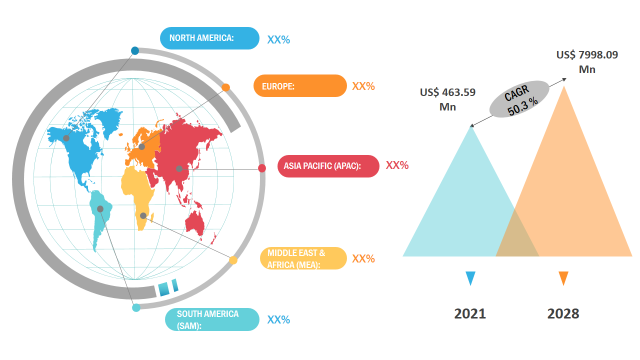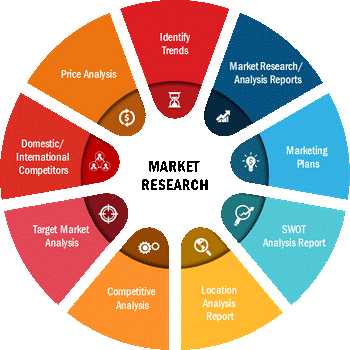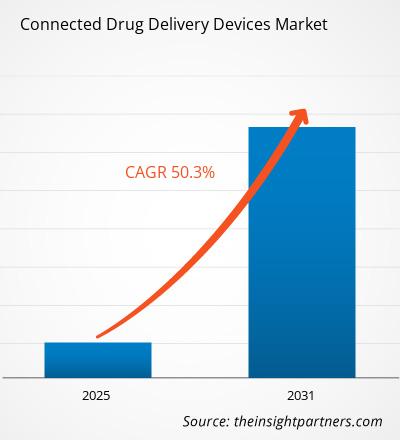Der Markt für vernetzte Arzneimittelverabreichungsgeräte wird voraussichtlich von 463,59 Millionen US-Dollar im Jahr 2021 auf US-Dollar wachsen 7.998,09 Millionen US-Dollar bis 2031; Es wird erwartet, dass sie von 2022 bis 2031 mit einer jährlichen Wachstumsrate von 50,3 % wachsen wird.
Die zunehmende Zahl von Patienten, die an Diabetes, Asthma, Bluthochdruck, Tuberkulose, Multipler Sklerose, klinisch isoliertem Syndrom, chronisch obstruktiver Lungenerkrankung (COPD), Hepatitis C und anderen chronischen Krankheiten leiden, und die wachsende Bedeutung von medizinischem Fachpersonal zur Vorsorge treiben das Wachstum des vernetzte Arzneimittel voran Markt für Liefergeräte. Vernetzte Arzneimittelverabreichungsgeräte werden mithilfe eingebetteter Elektronik und Sensoren hergestellt. Die Geräte sind so konzipiert, dass sie Informationen zur Selbstverabreichung sammeln und Echtzeitdaten zur Dosiseinhaltung vom Gerät an das Smartphone des Patienten und die Datenbank des HCP übertragen. Als Ergebnis Aufgrund der Konnektivität zur Medikamentenverabreichung hilft die Remote-Compliance dabei, potenzielle Komplikationen aufzuzeigen, die zu schlechten Behandlungsergebnissen führen könnten. Während des COVID-19-Ausbruchs war es Patienten untersagt, Krankenhäuser aufzusuchen, um die Ausbreitung der Virusinfektion zu verhindern. Um die soziale Distanz aufrechtzuerhalten, waren Patienten und medizinisches Fachpersonal daher auf Selbstverabreichung und Fernüberwachung angewiesen.
MARKTTYNAMIK
Das Wachstum von Der Markt für vernetzte Arzneimittelverabreichungsgeräte ist hauptsächlich auf die steigende Zahl von Patienten mit chronischen Krankheiten, die wachsende Nachfrage nach Fernüberwachung von Patienten und die steigende Nachfrage seitens der geriatrischen Bevölkerung zurückzuführen. Allerdings hemmen die hohen Kosten der Geräte das Wachstum des Marktes. Darüber hinaus ist die Annahme von Partnerschaften, Fusionen & Es wird erwartet, dass Akquisitionen, Kooperationen und andere strategische Initiativen zwischen Marktteilnehmern das Marktwachstum im Prognosezeitraum vorantreiben.
MARKTUMFANG
Die „Globale Marktprognose für vernetzte Arzneimittelverabreichungsgeräte bis 2031“ lautet: Ziel des Berichts ist es, einen Überblick über den Markt für vernetzte Arzneimittelverabreichungsgeräte mit detaillierter Marktsegmentierung nach Typ, Technologie und Endbenutzer zu geben. Der Bericht liefert wichtige Marktstatistiken, die auf den finanziellen Leistungen der führenden Akteure basieren. Es bietet auch wichtige Trends und Chancen auf dem Markt.
Strategische Einblicke
MARKTSEGMENTIERUNG
Der globale Markt für vernetzte Arzneimittelverabreichungsgeräte ist nach Typ, Technologie und anderen Kriterien segmentiert Endbenutzer. Basierend auf der Art ist der Markt in vernetzte Sensoren, integrierte Geräte sowie Plattform- und Kommunikationssysteme unterteilt. Dienstleistungen. Der Markt für das Segment der vernetzten Sensoren ist weiter in vernetzte Inhalationssensoren und vernetzte Injektionssensoren unterteilt. Der Markt für das Segment der integrierten Geräte ist in vernetzte Inhalationsgeräte und vernetzte Injektionsgeräte unterteilt. Basierend auf der Technologie ist der globale Markt für vernetzte Arzneimittelverabreichungsgeräte in Bluetooth, Mobilfunknetze und Near Field Communication (NFC) und andere. Der Markt ist nach Endverbraucher in Krankenhäuser, häusliche Pflege und andere unterteilt.
Der globale Markt für vernetzte Arzneimittelverabreichungsgeräte ist in fünf Hauptregionen unterteilt: Nordamerika, Europa, Asien-Pazifik, Naher Osten &Ampere; Afrika sowie Süd- und Afrika Zentralamerika. Der Bericht umfasst eine Analyse und Prognose von 18 Ländern auf der ganzen Welt sowie die in der Region vorherrschenden Trends und Chancen.
Aus regionaler Sicht dominiert Nordamerika den Markt für vernetzte Arzneimittelverabreichungsgeräte mit einem Marktanteil von ca. 35 % im Jahr 2021. Steigende Kopfausgaben für das Gesundheitswesen und die < Eine zunehmende Übernahme von Fortschritten bei Produkteinführungen und damit verbundene Innovationen stärken das Wachstum des regionalen Marktes. Die folgende Abbildung zeigt den Umsatzwachstumstrend im Markt für vernetzte Arzneimittelverabreichungsgeräte:

Quelle: The Insight Partners Analysis
Der Bericht analysiert Faktoren wie Treiber, Einschränkungen, Chancen und zukünftige Trends, die sich auf die Vernetzung auswirken Markt für Arzneimittelverabreichungsgeräte. Es bietet außerdem eine umfassende Analyse der fünf Kräfte von Porter zu den Faktoren, die den Markt beeinflussen.
Während des COVID-19-Ausbruchs stieg die Nachfrage nach vernetzten Medikamentenverabreichungsgeräten, was zu einem hohen Auftragsvolumen bei den Arzneimittelherstellern und damit zu einem höheren Produktionsvolumen vernetzter Sensoren führte. Aufgrund der COVID-19-Krise und der Umstellung von Einzelpersonen und medizinischem Fachpersonal auf Methoden zur Fernüberwachung von Patienten hat die Nachfrage nach vernetzten Medikamentenverabreichungsgeräten in der jüngsten Vergangenheit zugenommen. Es wird erwartet, dass sich dieser Trend im Prognosezeitraum fortsetzt.
MARKTTEILNEHMER
Der Bericht behandelt wichtige Entwicklungen auf dem Markt für vernetzte Arzneimittelverabreichungsgeräte . Verschiedene Unternehmen konzentrieren sich auf organische Wachstumsstrategien wie Produkteinführungen, Produktzulassungen, Patente und Veranstaltungen. Anorganische Wachstumsstrategien wie Akquisitionen, Partnerschaften und Kooperationen haben die Ausweitung des Geschäfts und des Kundenstamms der Marktteilnehmer gefördert. Aufgrund der steigenden Nachfrage nach vernetzten Medikamentenverabreichungsgeräten werden die Akteure auf dem Markt für vernetzte Arzneimittelverabreichungsgeräte in den kommenden Jahren voraussichtlich lukrative Wachstumschancen erleben.
Der Bericht enthält die Profile der wichtigsten Unternehmen auf dem Markt für vernetzte Arzneimittelverabreichungsgeräte sowie deren SWOT-Analyse und Marktstrategien. Darüber hinaus konzentriert es sich auf führende Akteure der Branche. Unternehmensprofile, angebotene Komponenten und Dienstleistungen, Finanzinformationen der letzten drei Jahre und wichtige Entwicklungen der letzten fünf Jahre. Nachfolgend finden Sie eine Liste einiger Unternehmen, die auf dem Markt für vernetzte Arzneimittelverabreichungsgeräte tätig sind:
- •Propeller Health•Adherium Limited •West Pharmaceutical Services•FindAir•Phillips-Medisize•Biocorp•3M•Cohero Health•Merck Group•Andere Marktteilnehmer
Das engagierte Forschungs- und Analyseteam des Insight Partners besteht aus erfahrenen Fachleuten mit fortgeschrittener Statistikkompetenz und bietet verschiedene Anpassungsmöglichkeiten in der bestehenden Studie.

- Historische Analyse (2 Jahre), Basisjahr, Prognose (7 Jahre) mit CAGR
- PEST- und SWOT-Analyse
- Marktgröße Wert/Volumen – Global, Regional, Land
- Branche und Wettbewerbsumfeld
- Excel-Datensatz



Report Coverage
Revenue forecast, Company Analysis, Industry landscape, Growth factors, and Trends

Segment Covered
This text is related
to segments covered.

Regional Scope
North America, Europe, Asia Pacific, Middle East & Africa, South & Central America

Country Scope
This text is related
to country scope.
Trends and growth analysis reports related to Life Sciences : READ MORE..
The List of Companies
1. Phillips-Medisize
2. West Pharma
3. Aterica Inc.
4. Panasonic Corporation
5. BIOCORP
6. Merck KGaA
7. Propeller Health
8. Proteus Digital Health
9. Adherium Limited
10. Qualcomm Technologies, Inc.
The Insight Partners performs research in 4 major stages: Data Collection & Secondary Research, Primary Research, Data Analysis and Data Triangulation & Final Review.
- Data Collection and Secondary Research:
As a market research and consulting firm operating from a decade, we have published and advised several client across the globe. First step for any study will start with an assessment of currently available data and insights from existing reports. Further, historical and current market information is collected from Investor Presentations, Annual Reports, SEC Filings, etc., and other information related to company’s performance and market positioning are gathered from Paid Databases (Factiva, Hoovers, and Reuters) and various other publications available in public domain.
Several associations trade associates, technical forums, institutes, societies and organization are accessed to gain technical as well as market related insights through their publications such as research papers, blogs and press releases related to the studies are referred to get cues about the market. Further, white papers, journals, magazines, and other news articles published in last 3 years are scrutinized and analyzed to understand the current market trends.
- Primary Research:
The primarily interview analysis comprise of data obtained from industry participants interview and answers to survey questions gathered by in-house primary team.
For primary research, interviews are conducted with industry experts/CEOs/Marketing Managers/VPs/Subject Matter Experts from both demand and supply side to get a 360-degree view of the market. The primary team conducts several interviews based on the complexity of the markets to understand the various market trends and dynamics which makes research more credible and precise.
A typical research interview fulfils the following functions:
- Provides first-hand information on the market size, market trends, growth trends, competitive landscape, and outlook
- Validates and strengthens in-house secondary research findings
- Develops the analysis team’s expertise and market understanding
Primary research involves email interactions and telephone interviews for each market, category, segment, and sub-segment across geographies. The participants who typically take part in such a process include, but are not limited to:
- Industry participants: VPs, business development managers, market intelligence managers and national sales managers
- Outside experts: Valuation experts, research analysts and key opinion leaders specializing in the electronics and semiconductor industry.
Below is the breakup of our primary respondents by company, designation, and region:

Once we receive the confirmation from primary research sources or primary respondents, we finalize the base year market estimation and forecast the data as per the macroeconomic and microeconomic factors assessed during data collection.
- Data Analysis:
Once data is validated through both secondary as well as primary respondents, we finalize the market estimations by hypothesis formulation and factor analysis at regional and country level.
- Macro-Economic Factor Analysis:
We analyse macroeconomic indicators such the gross domestic product (GDP), increase in the demand for goods and services across industries, technological advancement, regional economic growth, governmental policies, the influence of COVID-19, PEST analysis, and other aspects. This analysis aids in setting benchmarks for various nations/regions and approximating market splits. Additionally, the general trend of the aforementioned components aid in determining the market's development possibilities.
- Country Level Data:
Various factors that are especially aligned to the country are taken into account to determine the market size for a certain area and country, including the presence of vendors, such as headquarters and offices, the country's GDP, demand patterns, and industry growth. To comprehend the market dynamics for the nation, a number of growth variables, inhibitors, application areas, and current market trends are researched. The aforementioned elements aid in determining the country's overall market's growth potential.
- Company Profile:
The “Table of Contents” is formulated by listing and analyzing more than 25 - 30 companies operating in the market ecosystem across geographies. However, we profile only 10 companies as a standard practice in our syndicate reports. These 10 companies comprise leading, emerging, and regional players. Nonetheless, our analysis is not restricted to the 10 listed companies, we also analyze other companies present in the market to develop a holistic view and understand the prevailing trends. The “Company Profiles” section in the report covers key facts, business description, products & services, financial information, SWOT analysis, and key developments. The financial information presented is extracted from the annual reports and official documents of the publicly listed companies. Upon collecting the information for the sections of respective companies, we verify them via various primary sources and then compile the data in respective company profiles. The company level information helps us in deriving the base number as well as in forecasting the market size.
- Developing Base Number:
Aggregation of sales statistics (2020-2022) and macro-economic factor, and other secondary and primary research insights are utilized to arrive at base number and related market shares for 2022. The data gaps are identified in this step and relevant market data is analyzed, collected from paid primary interviews or databases. On finalizing the base year market size, forecasts are developed on the basis of macro-economic, industry and market growth factors and company level analysis.
- Data Triangulation and Final Review:
The market findings and base year market size calculations are validated from supply as well as demand side. Demand side validations are based on macro-economic factor analysis and benchmarks for respective regions and countries. In case of supply side validations, revenues of major companies are estimated (in case not available) based on industry benchmark, approximate number of employees, product portfolio, and primary interviews revenues are gathered. Further revenue from target product/service segment is assessed to avoid overshooting of market statistics. In case of heavy deviations between supply and demand side values, all thes steps are repeated to achieve synchronization.
We follow an iterative model, wherein we share our research findings with Subject Matter Experts (SME’s) and Key Opinion Leaders (KOLs) until consensus view of the market is not formulated – this model negates any drastic deviation in the opinions of experts. Only validated and universally acceptable research findings are quoted in our reports.
We have important check points that we use to validate our research findings – which we call – data triangulation, where we validate the information, we generate from secondary sources with primary interviews and then we re-validate with our internal data bases and Subject matter experts. This comprehensive model enables us to deliver high quality, reliable data in shortest possible time.

 Holen Sie sich ein kostenloses Muster für diesen Bericht
Holen Sie sich ein kostenloses Muster für diesen Bericht